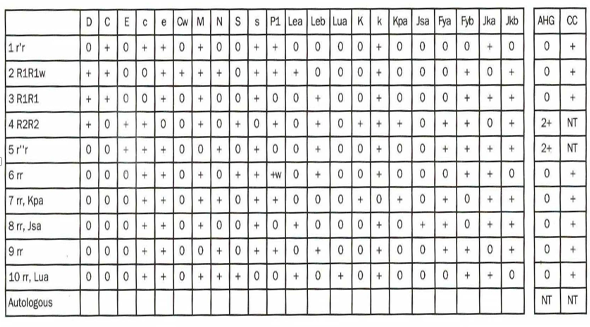74 Problem Solving Exercise on DAT’s and Elutions
This exercise is to enhance testing and work performed in the student labs. Exercises are not compulsory but students are encouraged to complete them and then request an answer key from the instructor to keep on track with their learning. If students find they are having difficulty with any exercise, they should request additional help from the instructor.
A 26 year old woman with systemic lupus erythematosus has autoimmune hemolytic anemia. Her hematocrit is 0.18. Her physician wants 1 unit of packed red blood cells for transfusion because her resting pulse is 125 beats per minute even though she is at bed rest and breathing oxygen by nasal cannula. The patient has not been previously transfused but has had one child. Clotted blood for testing gives the following results:
ABO/Rh typing
| Anti-A | Anti-B | Anti-D | Rh control | A1 cell | B cell |
|---|---|---|---|---|---|
| 0 | 0 | 3+ | 3+ | 4+ | 4+ |
Antibody Screen
| IS | 37 Degrees | AHG | CCC | ||
|---|---|---|---|---|---|
| I | R1R1 | 0 | 0 | 2+ | Not tested |
| II | R2R2 | 0 | 0 | 2+ | Not tested |
| III | rr | 0 | 0 | 2+ | Not tested |
Answer the following questions based on the above results.
- Can you determine the patient’s blood type? If so, what is it? If not, how would you determine it?
- What type of blood should this patient receive if needed immediately?
Because the Rh control is positive on this patient, the technologist performs a direct antiglobulin test on the patient’s red blood cells. The results are as follows:
| Polyspecific | Anti-IgG | Anti-C3 |
|---|---|---|
| 2+ | 2+ | 0 |
Based on these results what can be said about the initial antibody screen?
The technologist performs a warm autoabsorption of the patient’s serum with papain/DTT-treated (ZZAP) autologous red blood cells. The results of the antibody screen using the absorbed serum are below.
Antibody Screen on Absorbed Serum
| IS | 37 Degrees | AHG | CCC | ||
|---|---|---|---|---|---|
| I | R1R1 | 0 | 0 | 0 | 2+ |
| II | R2R2 | 0 | 0 | 2+ | Not tested |
| III | rr | 0 | 0 | 0 | 2+ |
The results of an antibody identification panel using the absorbed serum are given in the panel below. Please answer the following questions using this patient’s absorbed serum results.
- What antibody is most likely present?
- How should blood be crossmatched for this patient?

